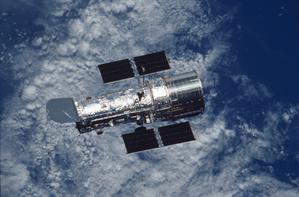Glossary term: Space Telescope
Description: Electromagnetic radiation from space has to first pass through the Earth's atmosphere before it can be collected by ground-based telescopes. Gamma rays, X-rays, ultraviolet, and some kinds of infrared radiation are filtered out completely by the atmosphere. To observe them, astronomers use space telescopes, which are sometimes also called space observatories: Automated satellites above the atmosphere that carry a telescope and instruments, plus the equipment needed to orient the spacecraft towards a specific target, receive commands, and transmit data back to Earth. As the twinkling of stars shows, even light that passes through the atmosphere is disturbed in the process. Here, too, space telescopes can help. However, space telescopes are difficult to repair. Most space telescopes are either in Earth orbit (such as the Hubble Space Telescope), or at the so-called Lagrange point L2 (such as the James Webb Space Telescope).
Related Terms:
See this term in other languages
Term and definition status: This term and its definition have been approved by a research astronomer and a teacher
The OAE Multilingual Glossary is a project of the IAU Office of Astronomy for Education (OAE) in collaboration with the IAU Office of Astronomy Outreach (OAO). The terms and definitions were chosen, written and reviewed by a collective effort from the OAE, the OAE Centers and Nodes, the OAE National Astronomy Education Coordinators (NAECs) and other volunteers. You can find a full list of credits here. All glossary terms and their definitions are released under a Creative Commons CC BY-4.0 license and should be credited to "IAU OAE".
If you notice a factual error in this glossary definition then please get in touch.
Related Media
Hubble Space Telescope over Earth
Credit: NASA/ESA credit link
License: CC-BY-4.0 Creative Commons Attribution 4.0 International (CC BY 4.0) icons









